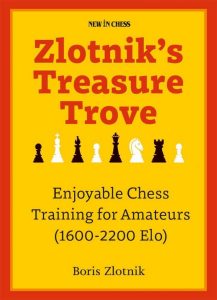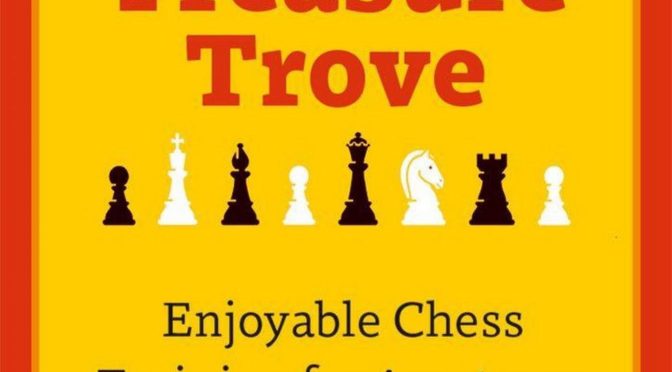From the publisher:
“Boris Zlotnik is an extraordinary trainer and coach. He was the director of a legendary chess school in Moscow before he emigrated to Spain in 1993. Ten years later, the super talent Fabiano Caruana moved to Madrid with his entire family to live near his trainer Zlotnik.
As a former coach of U.S. Champion Caruana, Zlotnik knows how top players work on their chess improvement. And his experience with club players allows him to translate that understanding into practical lessons for amateurs about highly original subjects like creativity or ‘putting up resistance’ – topics seldom touched on in other chess manuals.
Zlotnik covers a wide variety of topics and uses a wealth of material. Readers will love this new book, as they did his first book, Zlotnik’s Middlegame Manual. ‘A brilliant, important and extraordinarily instructive book’, said Florian Jacobs, the book reviewer for the Max Euwe Center in Amsterdam. ‘This is how probing, rich and motivating studying chess can be.'”
The publisher have provided sample pages
A slightly strange title, and perhaps a contradictory subtitle. I’m not sure that Zlotnik is exactly a household name, and therefore one that would sell more copies by its appearance on the cover. Dvoretsky’s books certainly sold by virtue of having his name in the title, but will Zlotnik do the same? If you thought more chess trainers should be household names, I wouldn’t disagree with you.
Treasure Trove? Buried treasure. According to Wiki:
The term is also often used metaphorically. Collections of articles published as a book are often titled Treasure Trove, as in A Treasure Trove of Science. This was especially fashionable for titles of children’s books in the early- and mid-20th century.
So perhaps that’s what we have here: a collection of articles about chess training. A lucky dip. A grab bag. But given Zlotnik’s reputation one that will undoubtedly be worth reading.
But then Enjoyable Chess Training for Amateurs sounds like something rather more formal and structured. Kudos to the publishers, though, for highlighting the target market (1600-2200 Elo). Regular readers of my reviews will know that I’m frequently critical of publishers who claim books are suitable for much wider target markets and much lower rated players than they really are.
I was also wondering whether anyone would buy a book promising ‘unenjoyable’ or ‘boring’ chess training. But never mind: let’s look inside.
In his preface, Zlotnik describes the book’s contents. He appreciates that most amateur chess players have other demands on their time: there are books available for ambitious young players prepared to devote several hours a day to improving their chess, but this isn’t one of them.
He concludes like this:
I share the following opinion with the sixth World Champion Mikhail Botvinnik: ‘It is not possible to teach someone to play chess well, but this is something that can be achieved through ones own efforts.’ This book is a book of reflections on chess, rather than an attempt to teach how to play well, and its aim is to demonstrate the richness and at the same time the difficulty of chess and the possible ways to get better at this game.
I also agree with Botvinnik. Many parents seem to think that if their children spend an hour a week with a strong player they’ll learn by osmosis, and that the stronger the player the more they’ll learn. You, I’m sure, will realise that this is nonsense. But that’s something for another time and place.
In Chapter 1, Zlotnik talks about the difference between amateurs and professionals, about the nature of chess talent, and about chess itself. An interesting read, but you won’t find any chess training there.
Chapter 2 is Factors which determine success in chess. We look at the different thought processes required for tactical and positional play. What they have in common is calculation: in tactical play you calculate forced variations while in positional play you calculate unforced variations.
In this position (Groningen 2013) IM Sergio Estremera Panos (2365) miscalculated against Jasel Lopez (2179). Rb7! would have won, but instead he blundered with Qe5?, when Ng7 gave the lower rated player a winning attack.
Chapter 3 provides advice on Training in tactical play. Like many chess coaches today, Zlotnik is very keen on training visualisation skills through blindfold play and other exercises. He also looks at Kotov’s views on tactical training outlined in Think Like a Grandmaster.
Here’s Zlotnik with another recommendation:
It is beyond doubt that chess problems and studies, by their very nature, present us with many more possibilities of encountering something original and are useful for us in training our combinative vision. … I think that a good criterion is to assess the ability to solve ‘mate in two’ problems, although exceptionally some of them are difficult even for GMs. Among especially creative puzzle composers, Samuel Loyd stands out, well-known above all for his mathematical puzzles.
Again, solving compositions of this nature is something now recommended by most leading chess coaches.
If you’re a tactical star (and that’s a big hint) you’ll be able to solve this mate in two composed by Sam Loyd in 1891.
Zlotnik also recommends, again following in Kotov’s footsteps, playing through a complex game, stopping at interesting points to analyse the position, and then comparing your analysis with that of the annotator or your computer. He then offers you Kramnik – Topalov (Skopje 2015), with ten questions for you to answer.
After training in tactical play, we have, naturally enough, Training in positional play in Chapter 4. Inevitably, given the nature of the subject, the advice here is of a rather more nebulous nature.
Something I don’t recall seeing before is this:
… usually you should attack your opponent’s most advanced piece or pawn, and if you cannot do so directly, then you should attack its base of support. Curiously, and in my experience, this very simple piece of advice is valid in many cases.
The next two chapters are what makes this book unusual. Chapter 5 tackles Creativity in chess. Zlotnik shows us some endgame studies, along with some games by Nezhmetdinov and the less well-known Konstantin Chernyshov. Click on any move for a pop-up window.
The exercises at the end of the chapter include some Proof Game puzzles, which are always fun. I used one of them here.
Chapter 6 then tells us how to put up Maximum resistance in practical situations.
If you’re in the target market for this book you’ll reach a bad position at some point in about half your games, so you might think this is an important subject which should be discussed more than it is. In 1967 Zlotnik asked Bronstein about the difference between masters and non-masters. He was surprised by the reply: a master knows how to fight against another human being!
In this extract, a dangerous tactician turns the tables on her strong opponent in a time scramble.
We then have 20 pages, plus two pages of exercises, on Studying the opening.
In this game the amateur playing white, unlike his opponent, was aware of a sharp tactical variation, but Black’s superior practical skill soon told.
Zlotnik concludes the chapter:
The main advice I can give to an amateur player is to seek a balance between specific knowledge of opening lines and typical ideas. Also, whatever the opening being studied, it is useful to have as a model an active high-level player who is an expert in the variation/opening we plan to play. From their games we can receive specific answers to any questions we might have and also learn a number of typical methods for this variation in the middlegame and perhaps also in the endgame.
Finally, the book wouldn’t be complete without Zlotnik’s ideas on Studying the endgame, which take up 18 pages along with three pages of exercises. As an example of what an amateur needs to know he devotes seven pages to some theory in the important ending of rook and pawn against rook.
His conclusion:
The endgame is a difficult science and it requires the investment of a great deal of work to master this aspect of the game.
This is a rather unusual coaching book, then, and I’m not sure whether either the title or subtitle does it justice. ‘Reflections of a Chess Coach” might give the prospective purchaser a better idea of what to expect. If you’re in the target market, an amateur rated between about 1600 and 2000 with a limited amount of time to spend on the game, it might be just what you’re looking for to help you put on another 100 points or so. But, while the examples and exercises have been chosen with exemplary care, this relatively slim volume will serve more as a guide to the sort of work you should be doing to make that improvement rather than something which will, in itself, bring it about.
For anyone with any interest at all in chess coaching, whether as an instructor or as a student, the opinions of one of the world’s most experienced and distinguished chess teachers will undoubtedly be both fascinating and inspiring. The book is produced to this publisher’s customary high standards and, if you’ve enjoyed the examples demonstrated in this review, it deserves a warm recommendation.
Richard James, Twickenham 19th September 2023

Book Details:
- Softcover: 248 pages
- Publisher: New In Chess (31 Mar. 2023)
- Language: English
- ISBN-10:9493257894
- ISBN-13:978-9493257894
- Product Dimensions: 17.25 x 1.6 x 22.91 cm
Official web site of New in Chess.
You can read some sample pages here.


